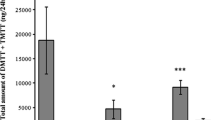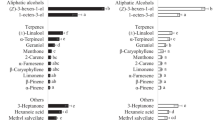Abstract
Antennal olfactory responses of the parasitoid,Microplitis croceipes (Cresson) (Hymenoptera: Braconidae), to 29 cotton volatile compounds were measured by electroantennogram (EAG) techniques. No significant sexual differences were found in EAGs of males and females to volatiles emanating from 100-μg stimulus loads of the 29 cotton compounds. Green leaf volatiles (saturated and monounsaturated six-carbon alcohols, aldehydes, and their acetate derivatives), heptanal, and the benzene derivatives, benzaldehyde and acetophenone, elicited the largest EAGs. Monoterpenes elicited moderate EAGs withβ-ocimene being the most effective monoterpene tested. Among the sesquiterpenes tested,β-bisabolol was the most effective stimulus at the 100-μg dose. Dose-response curves constructed from EAGs of females revealed a low threshold for (Z)-3-hexenyl acetate, a compound previously shown to be an effective attractant in wind-tunnel bioassays. Comparison of relative volatilities of the various odorants indicated differential selectivity and sensitivity ofM. croceipes antennal receptors to them. The roles of cotton plant volatiles in host habitat location ofM. croceipes are discussed.
Similar content being viewed by others
References
Baehrecke, E.H., Williams, H.J., andVinson, S.B. 1989. Electroantennogram responses ofCampoletis sonorensis (Hymenoptera: Ichneumonidae) to chemicals in cotton (Gossypium hirsutum L.).J. Chem. Ecol. 15:37–45.
Bouchard, Y., andCloutier, C. 1985. Role of olfaction in host finding by aphid parasitoidAphidius nigripes (Hymenoptera: Aphididae).J. Chem. Ecol. 11:801–808.
Camors, F.B., {jrJr.}, andPayne, T.L. 1972. Response ofHeydenia unica (Hymenoptera: Pteromalidae) toDendroctonus frontalis (Coleoptera: Scolytide) pheromones and a host-tree terpene.Ann. Entomol. Soc. Am. 65:31–33.
Chang, J.F., Benedict, J.H., Payne, T.L., andCamp, B.J. 1988. Volatile monoterpenes collected from the air surrounding flower buds of seven cotton genotypes.Crop Sci. 28:685–688.
Dicke, M., andSabelis, M.W. 1989. Does it pay plants to advertise for bodyguards? Towards a cost-benefit analysis of induced synomone production, pp. 341–358,in H. Lambers, M.L. Cambridge, H. Konings, and T.L. Pons (eds.).Causes and Consequences Variation in Growth Rate and Productivity of Higher Plants. SPB Academic Publishing, The Hague.
Dickens, J.C. 1984. Olfaction in the boll weevil,Anthonomus grandis Boh. (Coleoptera: Curculionidae): Electroantennogram studies.J. Chem. Ecol. 10:1759–1785.
Dickens, J.C. 1990a. Specialized receptor neurons for pheromones and host plant odors in the boll weevil,Anthonomus grandis Boh., (Coleoptera: Curculionidae).Chem. Senses 15:311–331.
Dickens, J.C. 1990b. Orientation to host plant and conspecifics by the boll weevil,Anthonomus grandis Boh. (Coleoptera: Curculionidae): Electrophysiological and behavioral correlations.Symp. Biol. Hung. 39:103–110.
Dickens, J.C., andBoldt, P.E. 1985. Electroantennogram responses ofTrirhabda bacharides (Weber) (Coleoptera: Chrysomelidae) to plant volatiles.J. Chem. Ecol. 11:767–779.
Dickens, J.C., andPayne, T.L. 1977. Bark beetle olfaction: Pheromone receptor system inDendroctonus frontalis.J. Insect Physiol. 23:487–489.
Dickens, J.C., Payne, T.L., Ryker, L.C., andRudinsky, J.A. 1984. Single-cell responses of the Douglas-fir beetle,Dendroctonus pseudotsugae Hopkins (Coleoptera: Scolytidae), to pheromones and host odors.J. Chem. Ecol. 10:583–599.
Dickens, J.C.,Smith, J.W., andLight, D.M. 1992. Green leaf volatiles enhance the sex attractant pheromone of the tobacco budworm,Heliothis virescens Boddie (Lepidoptera: Noctuidae).Chemoecology In press.
Ding, D., Swedenborg, P.G., andJones, R.L. 1989. Chemical stimuli in host-seeking behavior ofMacrocentrus grandii (Hymenoptera: Braconidae).Ann. Entomol. Soc. Am. 82:232–236.
Drost, T.C., Lewis, W.J., Zanen, P.O., andKeller, M.A. 1986. Beneficial arthropod behavior mediated by airborne semiochemicals: I. Flight behavior and influence of preflight handling ofMicroplitis croceipes (Cresson).J. Chem. Ecol. 12:1247–1262.
Eller, F.J., Tumlinson, J.H., andLewis, W.J. 1988. Beneficial arthropod behavior mediated by airborne semiochemicals II. Olfactometric studies of host location by parasitoidMicroplitis croceipes (Cresson) (Hymenoptera: Braconidae).J. Chem. Ecol. 14:425–434.
Elzen, G.W., Williams, H.J., andVinson, S.B. 1983. Response by the parasitoidCampoletis sonorensis (Hymenoptera: Ichneumonidae) to chemicals (synomones) in plants: Implications for host habitat location.J. Entomol. Soc. 12:1872–1876.
Elzen, G.W., Williams, H.J., andVinson, S.B. 1984. Isolation and identification of cotton synomones mediating searching behavior by parasitoidCampoletis sonorensis.J. Chem. Ecol. 10:1251–1264.
Fein, B.L., Reissig, W.H., andRoelofs, W.L. 1982. Identification of apple volatiles attractive to the apple maggot,Rhagoletis pomonella.J. Chem. Ecol. 8:1473–1487.
Guerin, P.M., andVisser, J.H. 1980. Electroantennogram responses of the carrot fly,Psila rosae, to volatile plant compounds.Physiol. Entomol. 5:111–119.
Hansson, B.S., Van der Pers, J.N.C., andLofqvist, J. 1989. Comparison of male and female olfactory cell response to pheromone compounds and plant volatiles in the turnip moth,Agrotis segetum.Physiol. Entomol. 14:147–155.
Hedin, P.A. 1976. Seasonal variation in the emission of volatiles by cotton plants in the field.Environ. Entomol. 5:1234–1238.
Hedin, P.A., Thompson, A.C., andGueldner, R.C. 1975. Survey of air space volatiles of the cotton plant.Phytochemistry 14:2088–2090.
Hopper, K.R., andKing, E.G. 1984. Preference ofMicroplitis croceipes (Hymenoptera: Braconida e) for instars and species ofHeliothis (Lepidoptera: Noctuidae).Environ. Entomol. 13:1145–1150.
Kovàts, E. Sz. 1961. Zuzammenhange zwischen Struktur and gas-chromatographischen Daten organischer Verbindunger.Z. Anal. Chem. 181:351–364.
Lewis, W.J., Sonnet, P.E., andNordlund, D.A. 1988. Responses of braconid parasitoidsMicroplitis croceipes (Cression) andM. demolitor Wilkinson to stereoisomers of kairomone 13-raethylhentriacontane.J. Chem. Ecol. 14:883–889.
Light, M.D., Jang, E.B., andDickens, J.C. 1988. Electroantennogram responses of the Mediterranean fruit fly,Ceratitis capitata, to a spectrum of plant volatiles.J. Chem. Ecol. 14:159–180.
Navasero, R.C., andElzen, G.W. 1989. Responses ofMicroplitis croceipes to host and nonhost plants ofHeliothis virescens in a wind tunnel.Entomol. Exp. Appl. 53:57–63.
Powell, J., andKing, E.G. 1984. Behavior of adultMicroplitis croceipes (Hymenoptera: Braconidae) and parasitism ofHeliothis spp. (Lepitodptera: Noctuidae) host larvae in cotton.Environ. Entomol. 13:272–277.
Ramachandran, R., andNorris, D.M. 1991. Volatiles mediated plant-herbivore-natural enemy interactions: Electroantennogram responses of soybean looper,Pseudoplusia includens, and a parasitoid,Microplitis demolitor, to green leaf volatiles.J. Chem. Ecol. 17:1665–1690.
Sato, T. 1979. Experimental studies on parasitization byApanteles glomeratus. IV. Factors leading a female to the host.Physiol. Entomol. 4:63–70.
Salkeld, E.H. 1959. Note on anatomy, life history, and behavior ofAphaereta pallipes (Say) (Hymenoptera: Braconidae), a parasite of the onion maggot,Hylemya antiqua (Meig.).Can. Entomol. 91:93–97.
Schneider, D. 1957. Elektrophysiologische Untersuchungen von Chemo- und Mechanorezeptoren der Antenne des SeidenspinnersBombyx mori. Z. Vergl. Physiol. 40:8–41.
Thompson, A.C., Baker, D.N., Gueldner, R.C., andHedin, P.A. 1971. Identification and quantitative analysis of the volatile substances emitted by maturing cotton in the field.Plant Physiol. 48:50–52.
Turlings, T.C., Tumlinson, J.H., andLewis, W.J. 1990. Exploitation of herbivore-induced plant odors by host-seeking parasitic wasps.Science 250:1251–1253.
Vet, L.M., Van Lenteren, J.C., Heymans, M., andMeelis, E. 1983. An airflow olfactory for measuring olfactory responses of hymenopterous parasitoids and other small insects.Physiol. Entomol. 8:97–106.
Vinson, S.B. 1981. Habitat location, pp. 51–57,in D.A. Nordlund, R.L. Jones, and W.J. Lewis (eds.) Semiochemicals: Their Role in Pest Control. John Wiley & Sons, New York.
Vinson, S.B. 1984. The chemical ecology of the parasitoid host relationship, pp. 205–233,in W.J. Bell and R.T. Cardé (eds.) Chemical Ecology of Insects. Chapman & Hall, London.
Visser, J.H. 1979. Electroantennogram responses of the Colorado beetle,Leptinotarsa decemlineata to plant volatiles.Entomol. Exp. Appl. 25:86–97.
Visser, J.H. 1986. Host odor perception in phytophygous insects.Annu. Rev. Entomol. 31:121–144.
Wellso, S.G., Buttery, R.G., andHoxie, R.P. 1984. Electroantennogram responses of the armyworm (Lepidoptera: Noctuidae) and cereal leaf beetle (Coleoptera: Chrysomelidae) to volatile chemicals of seeding oats.Great Lakes Entomol. 17:151–154.
Windholz, M. (ed.) 1983. The Merck Index, 10th ed. Merck & Co., Inc., Rahway, New Jersey. xv+1463 pp.
Whitman, D.W. 1988. Plant natural products as parasitoid cuing agents, pp. 387–396,in H.G. Cutler (ed.). Biologically Active Natural Products-Potential Use in Agriculture. ACS Publication, Washington, D.C.
Whitman, D.W., andEller, F.J. 1990. Parasitic wasps orient to green leaf volatiles.Chemoecology 1:69–75.
Author information
Authors and Affiliations
Rights and permissions
About this article
Cite this article
Li, Y., Dickens, J.C. & Steiner, W.W.M. Antennal olfactory responsiveness ofMicroplitis croceipes (Hymenoptera: Braconidae) to cotton plant volatiles. J Chem Ecol 18, 1761–1773 (1992). https://doi.org/10.1007/BF02751101
Received:
Accepted:
Issue Date:
DOI: https://doi.org/10.1007/BF02751101




